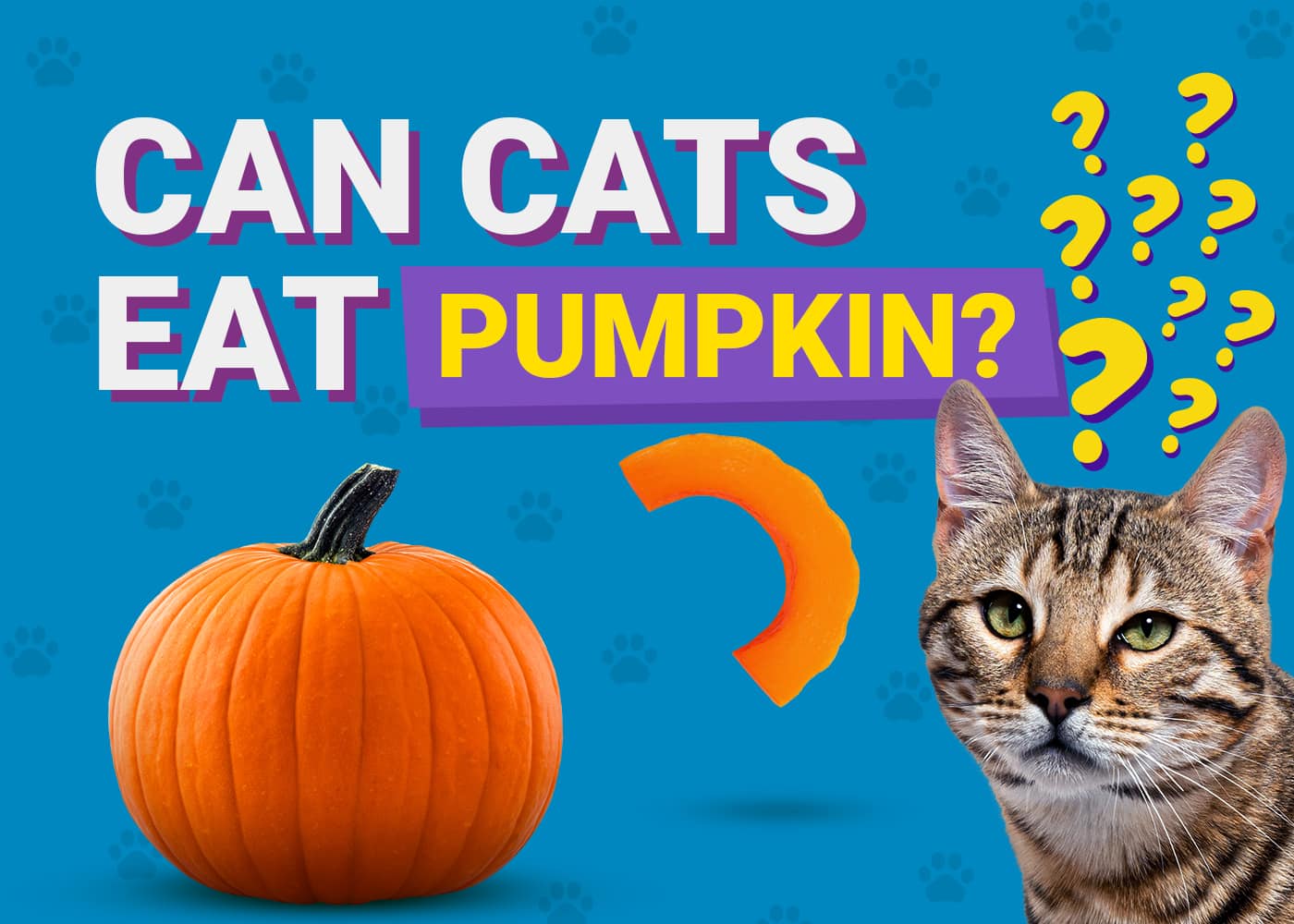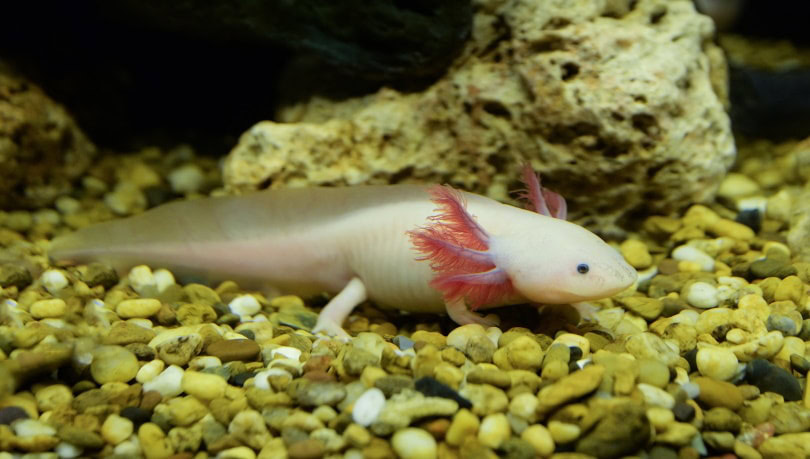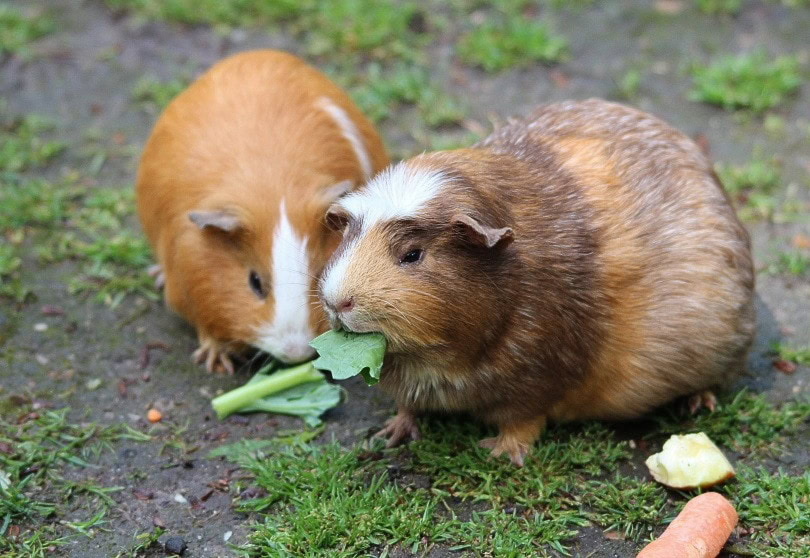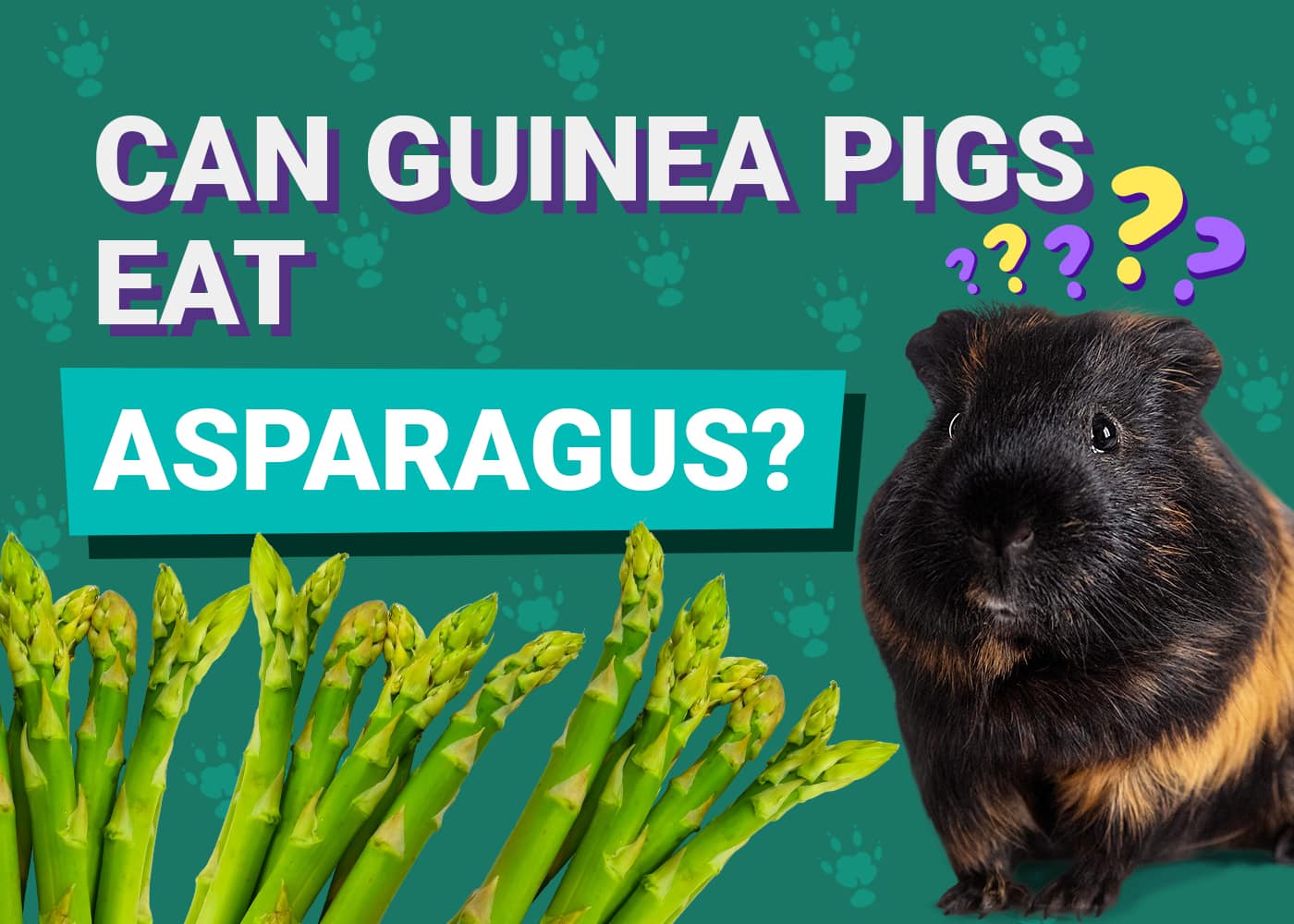VET APPROVED

The information is current and up-to-date in accordance with the latest veterinarian research.
Learn more »Click to Skip Ahead
Fall is the perfect time of year to enjoy all sorts of pumpkin treats, from roasted seeds to pumpkin pie. If you have a cat at home, their curiosity might convince them to steal a bite of pumpkin for themselves. Pumpkin is relatively safe for cats to eat, but if it’s prepared incorrectly or overused, it can have unintended consequences.
Many cats won’t have a problem with a small amount of pumpkin being added to their diet. The key is moderation and correct preparation, so we put together this guide to show you the best way to add pumpkin to your cat’s diet.

Can Cats Eat the Pumpkin Stem and Skin?
The stem and the skin are the parts that your cat is likely to come into contact with first. You may have left your carving pumpkin unattended while you brought in the rest of the groceries, or your Jack-O-Lantern is perched in a place of honor in the window.
Both the stem and the skin are harder than the insides of the pumpkin. This makes it very unlikely for your cat to ingest those parts. But, in the unlikely scenario that they do, they are considered foreign objects as they are impossible for your cat to digest. If your cat swallows a chunk of pumpkin that is too big, it might get stuck in their throat or their digestive system. Either problem will result in a visit to your veterinarian. However, most cats won’t try to eat the pumpkin skin or stem.
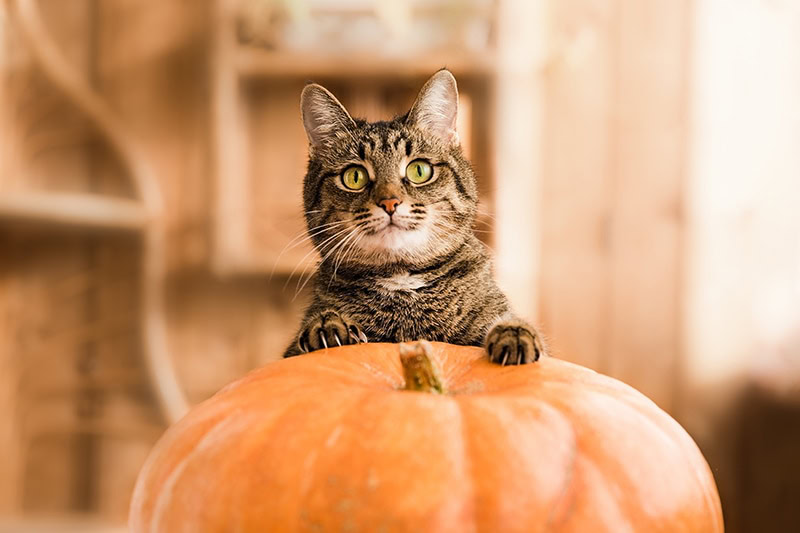
Can Cats Eat Pumpkin Guts?
If you’re not fond of pumpkin treats, you probably don’t have many of them around the house. But during Halloween, your curious feline might show interest in the bowl of seeds and pulp that were scooped out of your pumpkin-carving project.
In theory, the guts of a pumpkin are safer for your cat because nothing has been added to it. However, the long, stringy bits of raw pumpkin guts can be a hazard as they are not digestible and might act as a long foreign object, get entangled on your cat’s tongue, lodged in the stomach may result in further consequences causing the gut to plicate. In more severe cases, it could creating enough tension to damage the mucosa or cause the intestines to fold or invaginate. All these scenarios are high-risk medical emergencies and require veterinary intervention.
Also, the seeds are inedible when raw and can cause a choking risk or a blockage if your cat eats too many. If you want to give your cat the pumpkin seeds from the guts that you’re carving, make sure you roast or at least blend them first, and only give them a tiny amount.
Can Cats Eat Pumpkin Pie?
Pumpkin pie is an all-time favorite for Halloween and Thanksgiving, and while it’s a tasty treat for humans, pumpkin pie isn’t a safe option for your cat.
Canned pumpkin pie filling and the pies themselves may contain spices that are toxic to cats. Although they might not be fatal for your cat in small doses, many of these spices can upset your cat’s stomach. Combined with the high amount of sugar this dessert contains, pumpkin pie is generally unsuitable for a cat. If you do want to give pumpkin pie filling to your cat, make sure you only offer them the unsweetened variety (plain canned pumpkin), and double-check the ingredients first.
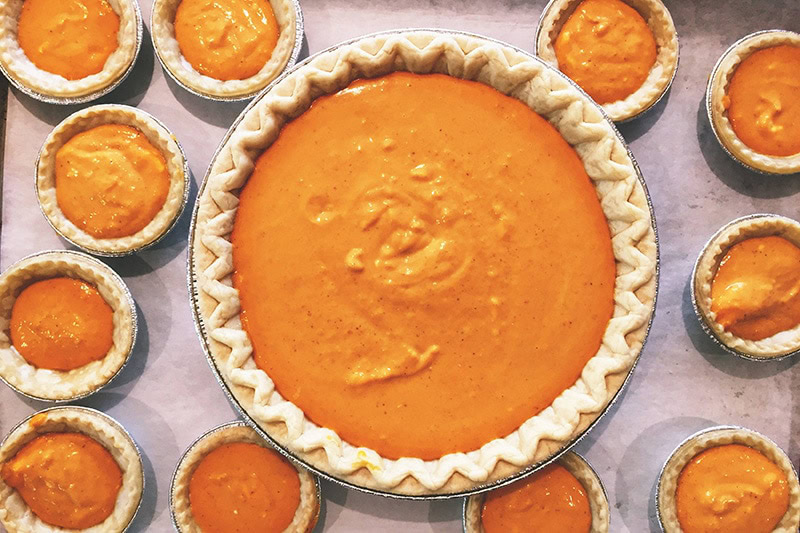

What Are the Dangers of Giving Pumpkins to Cats?
A piece of plain, baked, or boiled pumpkin isn’t toxic to cats, but you should still pay close attention to any risks of giving a new food to your cat. Pumpkin spice, whole raw pumpkin, pumpkin pie, and the seeds, stem, and skin can all pose unnecessary risks to your cat.
Allergies
Most cats don’t have a problem with consuming small pieces of baked or boiled pumpkin, but some cats can develop an allergic reaction to certain foods. While rare, pumpkin might be one of them, which is why you should always pay close attention to your cat after you’ve given them any new food. They could also be allergic to another ingredient in the pumpkin pie that they’ve sneaked a bite of.
An allergy—which shouldn’t be confused with food intolerance—is caused by your cat’s immune system overreacting to the food in question, in this case, the pumpkin. Allergic reactions can be moderate to severe.
- Overgrooming
- Itchy skin
- Hair loss
- Diarrhea
- Vomiting
If you notice any concerning signs like vomiting or diarrhea in your cat, get in contact with your vet. If you notice swelling or difficulty breathing, know that this is a medical emergency.
Choking Hazard
Many parts of a pumpkin are hard to chew, and your cat might swallow large pieces by accident, which is a choking risk. Besides the stem and the skin, the seeds—either raw or cooked—are a problem and can get lodged somewhere in your cat’s throat or digestive system.
Digestive Distress
Unlike us, cats are obligate carnivores.2 This means their diet should consist mostly of meat products. Therefore, cats shouldn’t ingest large amounts of plant products.
For cats, pumpkin isn’t a necessary part of their diet and can cause digestive upset.
The fiber content should also be considered. Although pumpkin is touted as a good cure for digestive upset, it can also cause issues like diarrhea or constipation when you introduce it to your cat’s diet too suddenly or if they eat too much.
Seasonings
Most pumpkin treats, like the pies or just the filling, contain additional seasonings to make them more appealing to human taste buds. However, these seasonings are often toxic to cats. Cloves and nutmeg, for example, are often used in pumpkin spice and are toxic to cats so is cinnamon when eaten in large amounts.3

What Are the Health Benefits of Pumpkin?
Used in the right way and in moderation, pumpkin can be healthy and completely safe for cats. It’s tasty and nutritious and supports your cat’s digestive and immune systems and their skin and coat health.

Digestive Health
Pumpkin is full of water and fiber and is a great, natural way to help soothe digestive problems like diarrhea, constipation, and even hairballs. Even plain and unsweetened canned pumpkin can help add extra moisture and fiber to your cat’s diet.
Antioxidant Source
Like most vegetables, pumpkin is full of antioxidants, vitamins, and minerals. These can help boost your cat’s immune system and protect your cat’s cells from free radical damage.
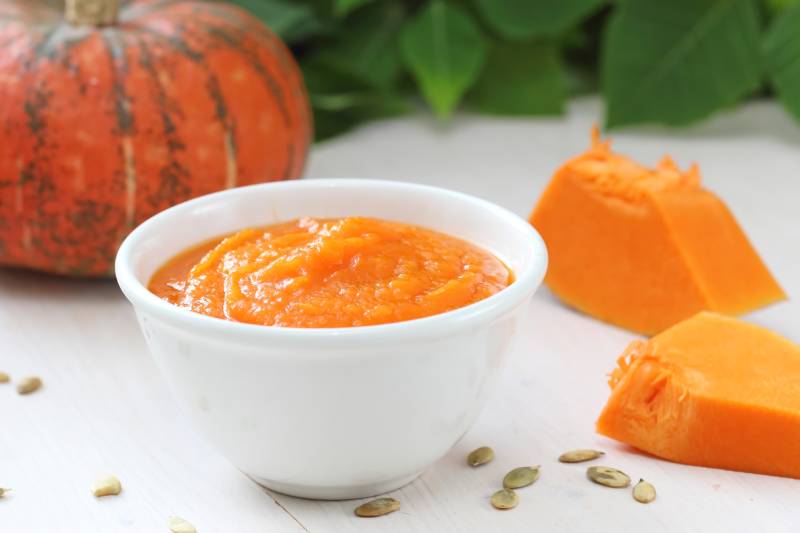

How to Prepare Pumpkin for Your Cat
There are various ways to prepare a pumpkin for your cat to suit all manner of taste preferences. Always make sure the pumpkin that you feed them is plain, unsweetened, and fully cooked, and never let it become more than 10% of their daily calorie intake.
Canned or Puréed
A few cats love to eat pumpkin straight out of the can. This is fine as long as you make sure it doesn’t have any additives, like sugar or other seasonings. If you’re not sure your canned pie filling is safe, buy a fresh pumpkin, and make your own pie filling by puréeing it yourself. This way, you can ensure that it’s as fresh as possible and has no dangerous ingredients.
Mixed With Food
Not all cats will enjoy eating pumpkin on its own and will often prefer meatier foods. This doesn’t mean you won’t be able to give pumpkin to them at all, though. If your cat refuses to eat pumpkin straight off a spoon, try mixing it into their dinner. You can do this with both wet and dry cat food.
Pumpkin Cat Treats
Another way that you can give pumpkin to your cat is by making cat treats. Look for cat-friendly recipes online or ask your veterinarian for advice. Many recipes designed for cats will often combine the pumpkin with meat of some kind to entice picky eaters. You can also make simple treats by making bite-size balls of puréed pumpkin and baking them.
Knowing exactly what your feline companion can and cannot eat will help you become the best pet parent. Recognizing that not all cat bowls are equal is also key! The Hepper NomNom Cat Bowl sets itself apart from traditional options by catering to the specific needs of cats. The innovative design offers whisker relief via shallow dishes and promotes digestion with a slight bowl elevation. Find out if the Hepper NomNom is right for your cat by clicking here. At PangoVet, we’ve admired Hepper for many years and decided to take a controlling ownership interest so that we could benefit from the outstanding designs of this cool cat company!

Conclusion
Pumpkin is a favorite fall vegetable for carving into jack-o-lanterns for Halloween or baking into a pie for Thanksgiving. If boiled or baked and without added sugars or spices, pumpkin is completely safe for your cat to enjoy too. Give it to your cat as a treat by adding a few teaspoons to their dinner or make cat-friendly pumpkin treats. Only use plain pumpkin, and avoid seasonings, sweeteners, the stem, skin, and seeds to make sure the treat is healthy and easy to digest.
Featured Image Credit: Pixabay
